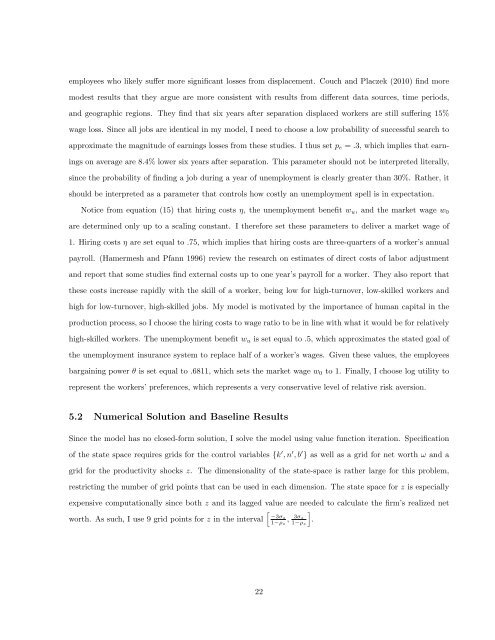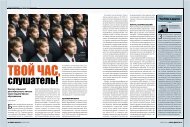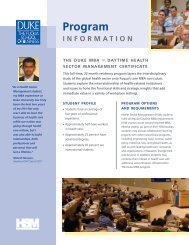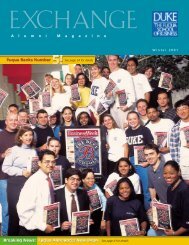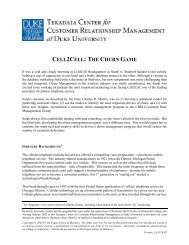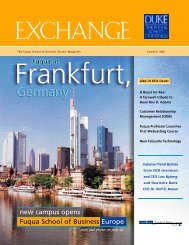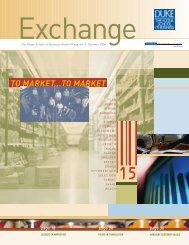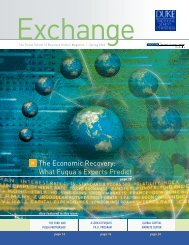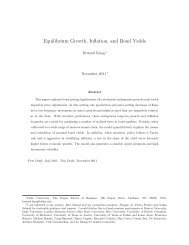A Structural Model of Human Capital and Leverage - Duke ...
A Structural Model of Human Capital and Leverage - Duke ...
A Structural Model of Human Capital and Leverage - Duke ...
Create successful ePaper yourself
Turn your PDF publications into a flip-book with our unique Google optimized e-Paper software.
employees who likely suffer more significant losses from displacement. Couch <strong>and</strong> Placzek (2010) find more<br />
modest results that they argue are more consistent with results from different data sources, time periods,<br />
<strong>and</strong> geographic regions. They find that six years after separation displaced workers are still suffering 15%<br />
wage loss. Since all jobs are identical in my model, I need to choose a low probability <strong>of</strong> successful search to<br />
approximate the magnitude <strong>of</strong> earnings losses from these studies. I thus set pe = .3, which implies that earn-<br />
ings on average are 8.4% lower six years after separation. This parameter should not be interpreted literally,<br />
since the probability <strong>of</strong> finding a job during a year <strong>of</strong> unemployment is clearly greater than 30%. Rather, it<br />
should be interpreted as a parameter that controls how costly an unemployment spell is in expectation.<br />
Notice from equation (15) that hiring costs η, the unemployment benefit wu, <strong>and</strong> the market wage w0<br />
are determined only up to a scaling constant. I therefore set these parameters to deliver a market wage <strong>of</strong><br />
1. Hiring costs η are set equal to .75, which implies that hiring costs are three-quarters <strong>of</strong> a worker’s annual<br />
payroll. (Hamermesh <strong>and</strong> Pfann 1996) review the research on estimates <strong>of</strong> direct costs <strong>of</strong> labor adjustment<br />
<strong>and</strong> report that some studies find external costs up to one year’s payroll for a worker. They also report that<br />
these costs increase rapidly with the skill <strong>of</strong> a worker, being low for high-turnover, low-skilled workers <strong>and</strong><br />
high for low-turnover, high-skilled jobs. My model is motivated by the importance <strong>of</strong> human capital in the<br />
production process, so I choose the hiring costs to wage ratio to be in line with what it would be for relatively<br />
high-skilled workers. The unemployment benefit wu is set equal to .5, which approximates the stated goal <strong>of</strong><br />
the unemployment insurance system to replace half <strong>of</strong> a worker’s wages. Given these values, the employees<br />
bargaining power θ is set equal to .6811, which sets the market wage w0 to 1. Finally, I choose log utility to<br />
represent the workers’ preferences, which represents a very conservative level <strong>of</strong> relative risk aversion.<br />
5.2 Numerical Solution <strong>and</strong> Baseline Results<br />
Since the model has no closed-form solution, I solve the model using value function iteration. Specification<br />
<strong>of</strong> the state space requires grids for the control variables {k ′ , n ′ , b ′ } as well as a grid for net worth ω <strong>and</strong> a<br />
grid for the productivity shocks z. The dimensionality <strong>of</strong> the state-space is rather large for this problem,<br />
restricting the number <strong>of</strong> grid points that can be used in each dimension. The state space for z is especially<br />
expensive computationally since both z <strong>and</strong> its lagged value are needed to calculate the firm’s realized net<br />
worth. As such, I use 9 grid points for z in the interval<br />
22<br />
� −3σz<br />
1−ρz<br />
, 3σz<br />
1−ρz<br />
�<br />
.


